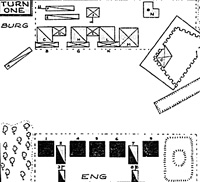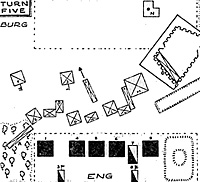TACTICAL USE ON THE WARGAMES TABLE
Because the knights are expensive, a Burgundian army is usually outscouted and outnumbered. The Burgundian flanks should be secured with gullies, marches and villages.
Some armies, like Vikings, have a high proportion of general purpose troops. The Burgundians, however, are an army of specialists. Victory is obtained by interweaving the specialists in a compatable manner.
Defeat results from using a troop type in ways not suited for its weapons, formation and morale. Command control is the key. Fortunately the W.R.G. 6th edition is generous in this regard and with a little forethought your units can advance, retire, shuffle about, dismount and remount just about as you desire. Since control is important avoid going impetuous as this will wreck unit coordination.
Cutting Edge Knights
The army has a thin cutting edge of knights. The knights are the tip of the spear and they close with and pin the enemy in melee. They are so few and so expensive that they should not be used in reserve, but must be out front. An attacker usually avoids strength and concentrates against weakness.
Experience, however, has shown that the knights must be hurled against the strongest point in the enemy line. The enemy's shock units must be tied up and immobilized as soon as possible. The Burgundians have a great mounted infantry and dismounted cavalry capability. You can move rapidly to the point of decision and if necessary, dismount to fight. If the knights are facing mounted enemy or LI they normally remain mounted. Otherwise, they dismount when in javelin range of the foe.
The coustiliers beef up the size of the Burgundian shock units by filling in behind the SHK. This makes it difficult for the enemy to obtain a C.P.F. In the dismounted mode their javelins assist in melee. When facing crossbows or exotics like elephants and scythed chariots the coustiliers interpenetrate up to the front of the unit.
The mounted archers move in company with the knights and provide close-in missile support for them. If the enemy routs at the knights first shock, the archers remount and pursue while the knights refrain from pursuit. If the enemy is pinned by the knights the archers charge through the intervals and encourage the halted enemy to recoil. High quality English mounted archers make a useful reserve under the command of a sub-general.
Missile Screen
The LI handgunners are a missile screen for the advancing knights, especially when faced with slings or longbows. These absorb long range missiles as long as their morale permits. When the lines close the LI are pulled out of the way, or is charged through, and support with fire through the intervals. Holding fire may prove useful and allow the Burgundians to disorder enemy animals.
The foot crossbows are useful in defending ramparted villages and steep hills. The enemy will have difficulty in casually dislodging these troops from those positions and they can support the knights with long range overhead fire. An "X" target priority is useful since they are good against armored cavalry.
The lance team pikes and foot bows are combined. These support the shoulders of the knightly attack. This type of unit can respond to enemy missiles and fend off enemy mounted troops. They can not withstand a major enemy push and if one is coming their way you have made a miscalculation and must quickly adj ust .
The LC crossbows help with the scouting and can screen a dangling flank. Their long range weaponry helps them to keep out of trouble. If you are faced with mass elephant units they operate best behind the main battle line shooting at the beasts.
Bombards are an expensive ornament. They can be used on an enemy reluctant to close and against enemy elephants.
An organ gun might prove effective in a palisaded village. If the enemy makes a serious attempt to storm it, the gates are opened and the gun shoots. The combination of missiles, artillery, surprise and unfriendly cover will halt all but elite troops.
AN EXAMPLE BATTLE
This miniature battle was between Burgundians and Medieval English. Figures used were 15mm while the rules were WRG's 6th Edition. Forces were 1250 points on a slightly cramped field of 700 paces by 500 paces. Army orders of battle were:
BURGUNDIANS
- A. LC, Reg "D", crossbow, 9 figs
B, G & K. Ll, Reg "D", handgun, 5 figs each
C, H & L. SHK, Reg "B", lance, 5 figs & MC, Reg "C", Javelins, 5 figs each
D, I & E. LMI, Reg "C", bow/2 hnd swd/horse, 10 figs each
F. General, SHK, Reg "A", lance, 3 figs & HC, Reg "B", Javs, 3 figs.
J. Sub-General, LMI, Reg "B", Ingbw/2 hnd swd/hrse 10 figs.
M. MI, Reg "D", 16 figs w/bow and 16 figs w/pike.
N. Artillery, one bombard and one organgun, Irg "C".
O. LMI, Reg "D", crossbow, 11 figs.
Noteworthy is that almost 50% of the Burgundian army is "D" Class.
-
1, 4, 5 & 6. HI, Reg"B",8 figs w/bill and 16 figs w/longbow
9. HI, Reg "B", 7 figs w/bills and 12 figs w/longbows
2 & 7. LC, Irg "C", lance/x-bow/shield, 6 figs ea.
3. Sub-General & HC, Reg "C", lance/shield, 5 figs.
8. General, EHK, Reg "B", lance/shield, 5 figs.
The Burgundians secured their left flank with a marsh palisaded village and gully. The English secured both of their flanks with a wood and steep hill. Since both armies used large numbers of missile troops they were careful to keep clear fields of fire between each other. Initial deployment was as illustrated with neither army being out-scouted.
 The English took a defensive position trying to maximize their longbows. The Burgundians force marched the foot crossbows to the forward ramparts of the village, and force marched the mounted crossbows out on the right flank to screen a contemplated envelopment. On the Burgundian left the mixed bow/pike unit placed the archers to the front with the pikes ready to interpenetrate forward if the enemy got close. The light infantry screened the knights, while the mounted archers were mostly dismounted to fire through the intervals and serve as a second assault wave.
The English took a defensive position trying to maximize their longbows. The Burgundians force marched the foot crossbows to the forward ramparts of the village, and force marched the mounted crossbows out on the right flank to screen a contemplated envelopment. On the Burgundian left the mixed bow/pike unit placed the archers to the front with the pikes ready to interpenetrate forward if the enemy got close. The light infantry screened the knights, while the mounted archers were mostly dismounted to fire through the intervals and serve as a second assault wave.
The Burgundians commenced a left wheel, pivoting on the village. The English sent forward a LC unit to slow down the Burgundian advance, but a brish missile volley caused that unit to retire shaken. English missiles fell mostly on expendable Burgundian "D" class infantry. As the lines closed one Burgundian Ll unit was driven off with missiles and the other two were contracted out of the way, while the Knights dismounted. The Burgundian mounted crossbows reached the woodline, dismounted, and started to flank the English position. The English interpenetrated the billmen forward.
 The second map shows unit positions at the start of Turn #5. The right most English unit wheeled towards the Burgundians while the rest of the English infantry charged the enemy to their front. English #1 recoiled their LMI opponent, but recoiled itself from the dismounted Knight
unit C. Unit #4 recoiled Unit D. Units #5 & 6 broke outright. On turn six Unit #9 was faced with heavy bow and crossbow casualties, artillery fire, unfriendly cover, routs, etc. and stalled being picked to pieces subsequently by point blank bow fire.
The second map shows unit positions at the start of Turn #5. The right most English unit wheeled towards the Burgundians while the rest of the English infantry charged the enemy to their front. English #1 recoiled their LMI opponent, but recoiled itself from the dismounted Knight
unit C. Unit #4 recoiled Unit D. Units #5 & 6 broke outright. On turn six Unit #9 was faced with heavy bow and crossbow casualties, artillery fire, unfriendly cover, routs, etc. and stalled being picked to pieces subsequently by point blank bow fire.
The victorious Knights were able to refrain from pursuing and they remounted. The Burgundian reserve unit moved up into a position to strike Unit #4, when it broke unit D. Assisted by close-in missile fire, Knights C broke Unit #1.
The start of turn #7 saw three English units in rout to one Burgundian unit. The English Commander conceded. Burgundian execution was sloppy in that the mounted archers were pushed to far forward and were caught by the English charge.
BIBLIOGRAPHY
Unlike most ancient armies, there is a mass of information available on the late Burgundian army. A person who can read French can, for example, discover the names of the more than 200 bodyguards of Charles the Bold. The best accounts of Burgundy, in the English language, is the five volume series by Richard Vaughan.
These are:
Vaughan. These are: Phillip the Bold, Harvard, 1962; Phillip the Good, N.Y., 1970; Charles the Bold, N.Y., 1974; Valois Burgundy, Hampden, Conn., 1975; John the Fearless, London, 1979.
The above can be usefully supplemented by: Commines, Phillipes de, Memoirs, Columbia, S.C., 1969 and Kirk, John F., History of Charles the Bold, 3 vol., Phila., 1864.
Wargaming the Burgundian Army
Back to Table of Contents -- Courier Vol. IV No. 2
© Copyright 1982 by The Courier Publishing Company.
This article appears in MagWeb (Magazine Web) on the Internet World Wide Web.
Other military history articles and gaming articles are available at http://www.magweb.com